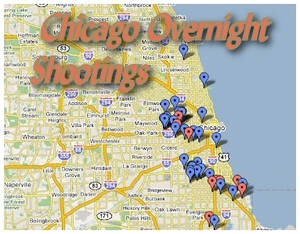By Sylvia Longmire
Mexico’s Drug War
“At least seven people…have been killed and 24 others wounded in a string of shootings in the US city of Chicago in the past two days.”
This was one very stark headline the morning of August 26, 2012. The attacks occurred in different parts of the city, with several in the south and west parts of the city. Shockingly, the statistics and incident details were reminiscent of grisly headlines emerging daily from a foreign city 1,500 miles away — Ciudad Juárez, arguably the deadliest place in the Western Hemisphere.

Juárez has been the epicenter of violence in Mexico’s drug war since 2007, when leaders of two major drug cartels —the Sinaloa Federation’s Joaquin “El Chapo” Guzmán and the Juárez cartel’s Vicente Carrillo Fuentes — failed to see eye-to-eye on a few things and went to war.
The annual murder rate skyrocketed, hitting the plateau of 3,622 people killed in 2010 (according to New Mexico State University researcher Molly Molloy) before dropping precipitously to 1,976 in 2011. The trend seems to be continuing into this year, with only 602 murders through August 14.
Chicago, however, is following a different trend.
A 2011 report by the Chicago Police Department shows the murder rate held relatively steady between 2004-2011, with a “low” of 433 in 2011 to a high of 513 in 2008. However, this occurred after over a decade of annual murder totals topping 900 during three years in the 1990s.
And it looks like 2012 is taking a turn for the worse again. Between the first of the year and August 23, 351 shooting deaths occurred in the city: 37 of those in July, 47 in June, and 51 in May.
The comparison to homicides in Ciudad Juárez this year is stunning — 45 were killed there in July, 49 in June, and 74 in May.
Of course, there are several ways in which Chicago and Ciudad Juárez differ that makes the similar numbers sit on footing that isn’t equal. Chicago has a population of roughly 2.7 million people, which is more than twice that of Ciudad Juárez at 1.3 million residents. The geography, industries, and average income levels are very different.
But the two cities might just have more in common than not.
Ciudad Juárez is notorious for its corrupt politicians and police officers, with an entire enforcement arm of the Juárez cartel, known as “La Línea,” being comprised almost completely of dirty local cops. Chicago doesn’t exactly have a squeaky clean record in this department, either.
In February 2012, University of Illinois at Chicago professor Dick Simpson, who served as alderman of the 44th Ward in Lakeview from 1971 to 1979, found that Chicago is the most corrupt city in the US through using US Department of Justice statistics.
It should come as no surprise that Chicago has a gang problem. Just over half of this year’s 297 victims so far had gang affiliations. While most of Ciudad Juárez’s violence has been attributed to the war between big cartels, the truth is more subtle. There are more than 500 gangs operating throughout the city’s 800 colonias, or neighborhoods. And the gangs are all doing the same thing, regardless of country or nationality — fighting for turf and drug profits.
According to the US Department of Justice, Mexican cartels dominate most trafficking of wholesale quantities of cocaine, heroin, and marijuana in the Chicago area. DEA Special Agent in Charge Jack Riley told CBS news last month that Mexican cartels have a significant influence on gang violence in Chicago, with three major cartels operating here and “turning parts of this Midwest city into a Mexican border town.”
Chicago’s increasing murder rate isn’t as simple as it seems — something that can just be labeled “typical gang violence” and addressed with more police patrols and neighborhood watches.
The roots of the violence run more deeply than some officials might be willing to acknowledge, and stem from another violent part of the hemisphere that is dangerously starting to look more and more similar to “The Windy City.”
Residents can only hope that city officials recognize the potential implications of the Chicago-Mexico connection and address them before the murder rate soars even higher.
Sylvia Longmire is a consultant and analyst with eight years of military law enforcement experience, six years of analytical experience covering Latin America, and over four years of analytical experience covering Mexican DTOs and border violence issues. Her blog is designed to inform readers about current border violence issues and provide analysis on those issues, as well as detailed focus on specific border topics. “By applying my knowledge and experience through this blog, I hope to separate the wheat from the chaff…that is, dispel rumors propagated by sensationalist media reporting, explain in layman’s terms what is going on with Mexican TCOs, and most importantly, WHY violence is happening along the US-Mexico border.”




